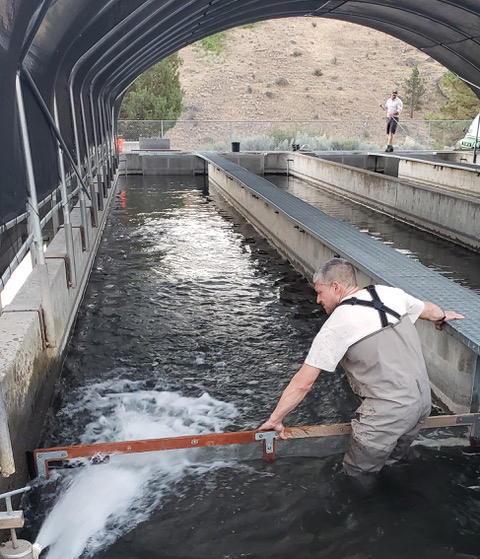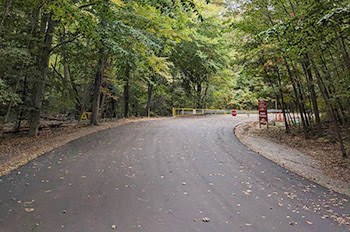Michigan state parks focus on visitor safety by becoming ‘StormReady’
DNR’s Parks and Recreation Division named a Weather-Ready Nation Ambassador
When a severe thunderstorm capable of producing damaging hail and 60-mph winds rolled through Yankee Springs State Recreation Area on a hot and humid Sunday afternoon in late July, park rangers were faced with a daunting task: ensuring the safety of the hundreds of visitors enjoying the park’s campgrounds, picnic areas and lakes.
After a flurry of activity – directing visitors to storm shelters, checking on the welfare of campers, avoiding trees that were toppled by the wind, and assessing other damage to the park – the weather eventually calmed and it became clear to the rangers that their mission had been accomplished.
Everyone was safe and sound, and the park’s rangers could point to their diligent planning and preparations throughout the day as central to the success of their efforts.
According to the park’s manager, the happy ending can be partly attributed to the National Weather Service’s “StormReady” program – a voluntary initiative that helps emergency managers and community leaders strengthen local safety and preparedness measures by ensuring they have the latest technology and communication tools (such as weather radios, emergency sirens and PA systems) in place to deal with sudden severe weather events.
 “We are in the process of applying to be certified as a StormReady facility, so we had the action plan and equipment in place that helped our staff handle the weather event in an organized manner,” said park manager Andru Jevicks.
“We are in the process of applying to be certified as a StormReady facility, so we had the action plan and equipment in place that helped our staff handle the weather event in an organized manner,” said park manager Andru Jevicks.
“Before the storm hit, our rangers got out into the campgrounds, picnic and beach areas, and boat launches, letting people know where they could take cover should a warning be issued, and it all went very smoothly,” Jevicks added. “This is not something you do on the fly. Being StormReady helps a lot.”
In Michigan, 17 state parks are certified by the NWS as StormReady, with Yankee Springs expecting to soon join the ranks. Nationwide, more than 2,000 facilities have received the designation since the program began in 1999.
“With millions of visitors coming to our parks each summer, we decided to take a proactive approach to weather safety and developed a partnership with the National Weather Service,” said Michael Evanoff, safety officer with the Michigan Department of Natural Resources Parks and Recreation Division.
“Through commitment and dedication to visitor safety, our employees have made this program a great success and the DNR is working toward making all of our state parks and recreation areas StormReady,” Evanoff said.
According to the NWS, StormReady communities are better prepared to save lives from the onslaught of severe weather through advanced planning, education and awareness.
“Michigan weather can be calm and tranquil, just perfect for enjoying our many state parks, but it can also become severe and dangerous rather quickly,” said Richard Pollman, warning coordination meteorologist at the National Weather Service’s Detroit/Pontiac office.
“Being prepared is key,” Pollman added, “and Michigan state parks have taken significant steps toward preparedness through this partnership with the National Weather Service.”
To be recognized as StormReady, parks must have a system in place to monitor the weather, receive weather alerts, and alert employees and visitors. Michigan’s StormReady state parks have also developed formal hazardous weather plans, which include training staff as weather spotters and holding emergency practice exercises.
StormReady parks display road signs at the entrances to inform visitors of the program. When visitors see these signs, they can be confident that the park’s staff has put significant time and concerted effort into preparing for severe weather events.
“I know for a fact that our visitors feel more comfortable knowing they’ll be notified in the case of severe weather,” said Interlochen State Park manager Chris Stark. “Even in the absence of severe weather, they’ve mentioned that they notice and appreciate the signs.”
While receiving StormReady certification does not mean a facility is storm proof, trained staff undoubtedly have an advantage when it comes to helping visitors safely weather the storm when severe weather strikes.
Visitors to StormReady parks are encouraged to stay alert to weather conditions and their surroundings, should they need to seek shelter while out hiking, boating or otherwise enjoying the outdoors. One step campers and other park visitors can take to stay informed is carrying a NOAA weather radio, which are available in portable, battery-operated models.
“Modern technology is a wonderful thing,” said Tim Anderson, who volunteers as a campground host at Bay City State Recreation Area — the first Michigan state park to attain StormReady status and only the third certified park in the nation.
“I use weather apps on my cell phone to keep informed of changing weather conditions. With a push of a button, I can access current weather forecasts as well as radar,” Anderson said. “It provides me with real-time data to help plan visitor activities and warn visitors of approaching storms.”
In recognition of the DNR’s Parks and Recreation Division’s commitment to attaining StormReady certification for individual parks, the National Oceanic and Atmospheric Administration recently named the Division a “Weather-Ready Nation Ambassador” – an initiative that formally recognizes organizations that have partnered with NOAA to strengthen national resilience against extreme weather, through such efforts as becoming StormReady.
“On any given day during the summer months, thousands of visitors may be in a state park,” said Parks and Recreation Division Chief Ron Olson. “If a severe storm develops, we want to be able to communicate the danger efficiently and potentially save lives. The Weather-Ready Nation Ambassador designation recognizes that we have one of the best warning systems in place.
“The efforts of our state park managers, rangers and other staff to protect visitors during severe weather events are just another example of the DNR’s commitment to providing the best state park experience in the country, and I commend our staff for their dedication to making safety the priority.”
To learn more about the StormReady and Weather-Ready Nation programs, visit www.stormready.noaa.gov/ and www.nws.noaa.gov/com/
Michigan’s StormReady state parks include:
Bay City, Fort Custer, Harrisville, Holland, Interlochen, Leelanau, Ludington, Charles Mears, Metamora-Hadley, Orchard Beach, Otsego Lake, Port Austin Harbor, Silver Lake, Sleeper, Tippy Dam, Traverse City and William Mitchell State Park. The DNR’s Grawn Field Office is also StormReady certified; Yankee Springs is in the process of becoming certified.





